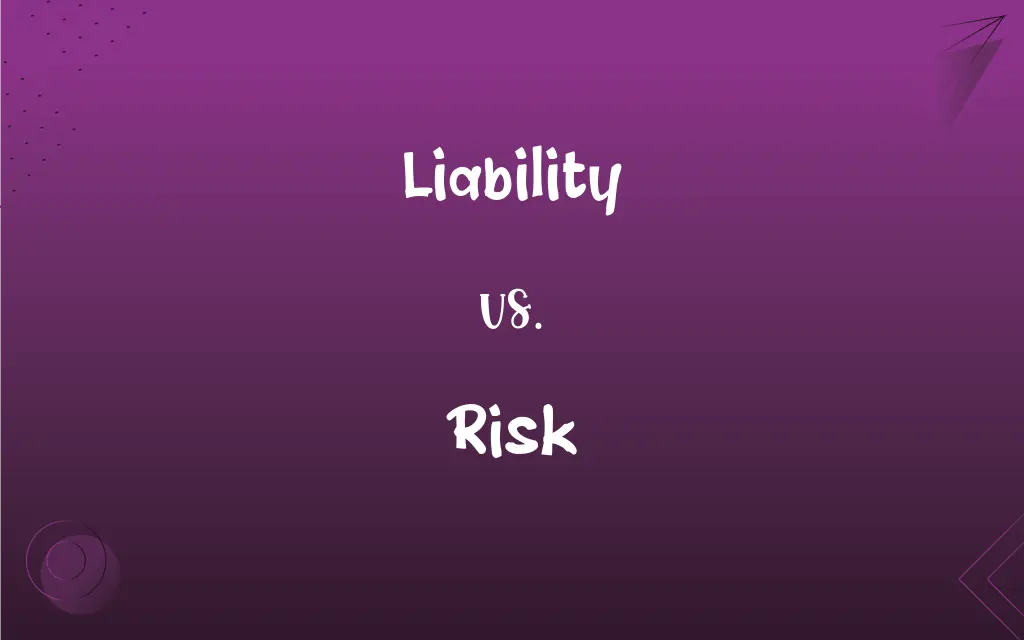Liability vs. Risk: What's the Difference?
Edited by Harlon Moss || By Janet White || Published on December 10, 2023
Liability is a legal responsibility or obligation, often involving financial repercussions; risk is the potential for loss or harm in a situation, usually uncertain and variable.

Key Differences
Liability refers to a legal obligation, typically involving a responsibility to compensate for damages or losses incurred. It's a defined and enforceable duty. Risk, in contrast, is the possibility of suffering harm or loss and is often assessed in terms of likelihood and impact.
Liability is a specific term in legal and financial contexts, implying an obligation that can arise from contracts, negligence, or other legal grounds. Risk is a broader concept, relevant in various contexts like finance, safety, and planning, denoting the chance of negative outcomes.
Liability is often quantifiable, especially in financial terms, as it relates to the obligation to pay or rectify. Risk, however, can be more difficult to quantify precisely as it involves estimating the probability and severity of future events.
In managing liability, the focus is on compliance with laws and regulations, and preparing for known obligations. Risk management, however, involves identifying, assessing, and prioritizing potential risks to minimize, monitor, and control the probability or impact of unfortunate events.
Liability can be transferred or insured against, such as through liability insurance. Risk, while it can be mitigated or shared, is inherent in all actions and decisions and must be constantly evaluated as situations change.
ADVERTISEMENT
Comparison Chart
Nature
Legal obligation or responsibility
Potential for loss or harm
Context
Legal and financial realms
Various contexts (finance, safety, etc.)
Quantification
Often quantifiable (e.g., financial terms)
Can be difficult to quantify (probability and impact)
Management Focus
Compliance with laws, preparation for obligations
Identifying, assessing, and prioritizing potential risks
Transferability
Can be transferred (e.g., insurance)
Inherent and constant, can be mitigated but not fully transferred
ADVERTISEMENT
Liability and Risk Definitions
Liability
A burden or disadvantage.
His lack of experience was a liability to the team.
Risk
A factor involving uncertainty.
Starting a business is a risk many entrepreneurs take.
Liability
Legal responsibility for damages.
The company faced liability for the environmental damage.
Risk
Exposure to danger.
Skydiving is an activity with high risk.
Liability
Something that acts as a hindrance.
Injuries can be a liability for professional athletes.
Risk
Probability of an adverse event.
There's a risk of rain during the outdoor event.
Liability
Obligation to make good on a loss.
The contractor's liability in the case was clear.
Risk
A venture of uncertain outcome.
Moving to a new city was a risk she was willing to take.
Liability
Financial debts or obligations.
The firm's liabilities exceeded its assets.
Risk
Possibility of loss or injury.
Investing in stocks involves financial risk.
Liability
The state of being liable.
Risk
The possibility of suffering harm or loss; danger.
Liability
Something for which one is liable; an obligation, responsibility, or debt.
Risk
A factor, thing, element, or course involving uncertain danger; a hazard
"the usual risks of the desert.
FAQs
Is risk always negative?
Primarily, though it can also offer potential rewards.
How do businesses manage liability?
By compliance with laws and maintaining insurance.
Can individuals have liabilities?
Yes, in various forms like debts or legal obligations.
How does liability differ from risk?
Liability is a legal obligation; risk is the potential for harm or loss.
Can liability be insured against?
Yes, through liability insurance policies.
Is risk quantifiable?
Often, in terms of likelihood and potential impact.
Can taking risks be beneficial?
Yes, if managed well, it can lead to growth and opportunity.
What is liability?
Legal responsibility for damages or losses.
Is public liability a concern for businesses?
Yes, as it involves potential claims by the public.
What are common risks in investments?
Market volatility, economic changes, and loss of capital.
What is risk management?
Identifying and mitigating potential losses or harms.
Does liability always arise from negligence?
Not always; it can also stem from contractual obligations.
Are all liabilities financial?
Many are, but not exclusively (e.g., legal responsibilities).
What is a risk assessment?
Evaluating the potential risks in a given situation.
What factors influence risk?
Environmental, economic, social, and personal factors.
How can risk be reduced?
Through planning, safety measures, and diversification.
Is professional liability different from personal liability?
Yes, it pertains specifically to professional conduct.
How is product liability managed?
By ensuring safety and compliance with standards.
Can liability be shared?
Yes, as in partnerships or joint ventures.
How do individuals manage personal risk?
Through insurance, savings, and cautious decision-making.
About Author
Written by
Janet WhiteJanet White has been an esteemed writer and blogger for Difference Wiki. Holding a Master's degree in Science and Medical Journalism from the prestigious Boston University, she has consistently demonstrated her expertise and passion for her field. When she's not immersed in her work, Janet relishes her time exercising, delving into a good book, and cherishing moments with friends and family.
Edited by
Harlon MossHarlon is a seasoned quality moderator and accomplished content writer for Difference Wiki. An alumnus of the prestigious University of California, he earned his degree in Computer Science. Leveraging his academic background, Harlon brings a meticulous and informed perspective to his work, ensuring content accuracy and excellence.






































































